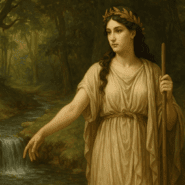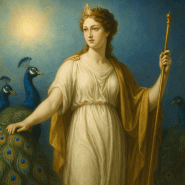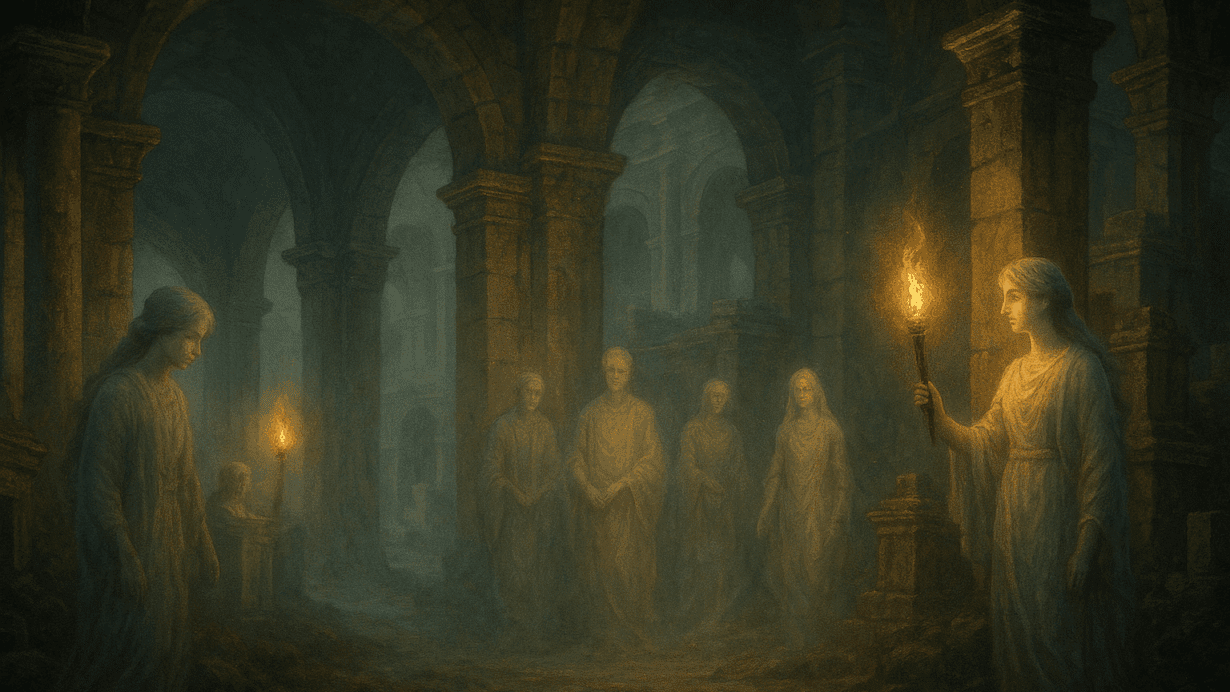QUICK SUMMARY
The Manes were the collective spirits of Rome’s honored dead. They formed a sacred bridge between the living and the afterlife, guiding memory, family rites, and Rome’s understanding of death itself.
Among the many divine forces of Roman religion, few were as important or as intimate as the Manes. They were not gods of distant myth or cosmic power; they were the ancestors, the spirits of family members who had moved beyond the world of the living into the shadowed realms of the dead. Yet they were never truly gone. Through ritual, remembrance, and daily devotion, the Manes remained active presences in Roman life.
To the Romans, the dead were not abstract figures. They watched, protected, and guided their descendants, reinforcing the bond between generations. Honoring the Manes was both a religious duty and a moral obligation. Through them, the Romans made sense of death, legacy, and the continuity of family.
The Roman term Manes can be pronounced in a few ways, with the most common English pronunciations being “MAH-nayz” or “MAY-neez”. For classical Latin, the pronunciation is closer to “MAH-nehs”.
Who Were the Manes?
The Manes were understood as the collective spirits of the deceased, honored and elevated through proper burial and ritual. The term encompassed all who had passed on, regardless of social class, provided they were given the reverence owed to them by tradition.
Rome distinguished several types of spirits within the world of the dead:
- Manes, the benevolent ancestral spirits
- Lares, often tied to households or geographic places
- Lemures, restless spirits who lacked proper rites
- Larvae, malevolent or wandering dead
The Manes represented peace and familial continuity. They were the ideal outcome of a life well-lived and properly honored in death.
The Role of the Manes in Roman Afterlife Beliefs
The Manes inhabited the Underworld, joining a realm where memory, ritual, and divine justice intertwined. For the Romans, becoming one of the Manes was not merely a passive fate but a transition to a new form of existence.
A State of Honor
When the funeral rites were completed, the soul passed peacefully into the realm of the Manes. There, it took its place among the honored ancestors who watched over the living.
A Bridge Between Realms
The Manes occupied a unique position. They were no longer mortal but not truly divine. Instead, they were spiritual guardians, capable of influencing the world through subtle blessings, protection, or symbolic communication.
Memory as Immortality
In Roman culture, to be remembered was to live on. Families carved the phrase D.M. (Dis Manibus) on tombstones — “to the divine Manes” — acknowledging the sacred transformation of the dead.
The Cult of the Manes
Honoring the Manes was one of the most ancient and enduring religious practices in Rome. Their veneration centered on the family, the home, and the rituals that preserved lineage.
Household Worship
Most Roman homes had altars dedicated to the Manes, where daily offerings might include bread, wine, milk, honey, and garlands. These offerings symbolized the ongoing relationship between the living and the ancestors.
Graveside Rituals
Families visited tombs regularly, bringing food and wine to share symbolically with departed loved ones. These gatherings reinforced the belief that the Manes remained part of the household even in death.
Sacred Sites
Larger cult centers, such as the Collegia Funeraticia, helped ensure proper rites for the poor or those without family. Even in death, Rome sought to protect the sanctity of the transition to the Manes.
Parentalia: Rome’s Festival of the Ancestral Dead
One of the most important Roman festivals was Parentalia, held each February. It was a solemn period devoted entirely to the Manes, marked by offerings, quiet reflection, and the temporary suspension of public activities.
Ritual Offerings
Families placed wreaths, grains, wine, and violet flowers at tombs. These gifts nourished the Manes, renewing the bond between generations.
Domestic Harmony
During Parentalia, the household sought harmony and peace. Disputes were avoided, no marriages took place, and no official business occurred. The dead were given priority over the living.
Public Acknowledgment
The festival culminated in the Feralia, a ritual of closure in which the dead were honored collectively. This day emphasized that the Manes were not only family but an integral part of Rome’s larger spiritual community.
Lemuria: Keeping the Manes at Peace
Not all spirits found rest. Some remained as lemures—restless ghosts. The purpose of Lemuria, held in May, was to appease or expel these unsettled spirits and reaffirm the distinction between the peaceful Manes and the wandering dead.
The head of the household would rise at midnight, walk barefoot through the home, and cast black beans behind him to draw away unwanted spirits. The ritual belonged among the most ancient of Roman traditions.
For those properly honored, however, the Manes required no such appeasement; they remained benevolent guardians.
The Manes and Roman Burial Customs
Roman burial practices were designed to transform the deceased into Manes. Without proper rites, the spirit might linger or become hostile.
Importance of Burial
Romans believed the soul could not access the Underworld until the body was prepared and laid to rest. Cremation or burial completed the journey, releasing the spirit to join the Manes.
Funerary Feasts
Banquets at the graveside celebrated the passage into the Manes. Portions of food were offered to the spirit, symbolizing its acceptance into the ancestral community.
Tomb Inscriptions
Similar phrases appear across Roman cemeteries:
- Dis Manibus Sacrum
- To the Sacred Spirits of the Dead
These inscriptions declared the deceased’s new identity among the honored ancestors.
Philosophical Interpretations of the Manes
Roman thinkers — especially the Stoics — saw the Manes through a philosophical lens. Some believed the Manes represented the return of the soul to nature or the cosmos. Others saw them as symbolic, embodiments of the enduring memory of the dead.
Even those who doubted literal afterlife existence often upheld Manes rituals, recognizing their cultural and moral importance.
The Legacy of the Manes
The Manes influenced centuries of funerary practice, religious belief, and cultural tradition. Their legacy continues in:
- Memorial rites
- Ancestral veneration
- Tombstone inscriptions
- Roman festivals tied to the dead
- Early Christian adaptation of ancestor-related rituals
Above all, they embodied Rome’s enduring belief that family, memory, and duty transcended death.
A Lasting Presence
To the Romans, the Manes were not simply spirits of the past but living presences in the rhythm of daily life. Honoring them maintained the harmony of the household and upheld the virtue of piety — pietas — the foundation of Roman moral life.
In this way, the Manes remain a powerful reminder of how the Romans viewed the world: a place where the living and the dead shared a sacred connection, woven through memory, love, and the rituals that kept families united across generations.








